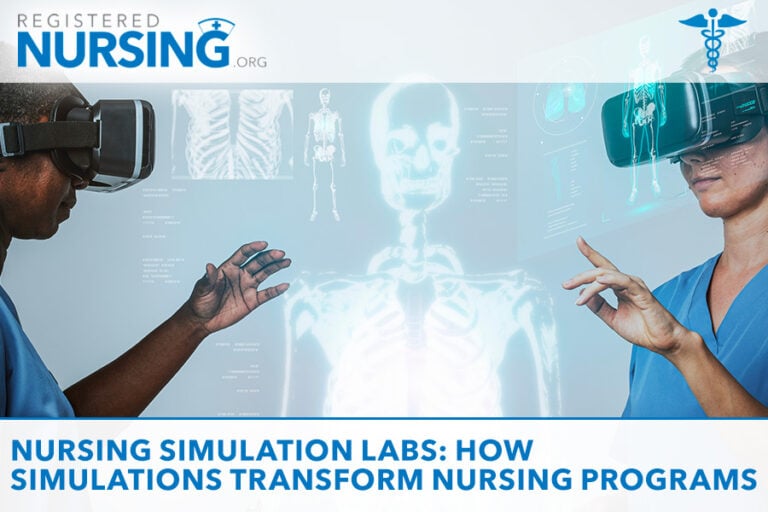Nursing Simulation Labs: How Simulations Transform Nursing Education
- Types of Simulation Used in Nursing Programs
- Simulation Across Different Nursing Degree Programs
- Anatomy of a Modern Nursing Simulation Lab
- How Simulation Enhances Nursing Education
- Evidence Supporting Simulation in Nursing Education
- Preparing for Simulation Success
- The Future of Nursing Simulation
- Frequently Asked Questions About Nursing Simulation
- Related Articles
- Latest Articles & Guides

Nursing education has undergone a revolutionary transformation with the integration of simulation technology. Today’s nursing students across Associate Degree in Nursing (ADN), Bachelor of Science in Nursing (BSN), Master of Science in Nursing (MSN), and even Doctor of Nursing Practice (DNP) programs benefit from sophisticated simulation experiences that bridge the gap between classroom learning and actual patient care.
This comprehensive guide explores how simulation labs have become central to nursing education, preparing students for the complexities of modern healthcare environments through realistic, risk-free practice scenarios.
Types of Simulation Used in Nursing Programs
Nursing programs incorporate various simulation methodologies to address different learning objectives:
High-Fidelity Patient Simulators
These advanced mannequins replicate human physiological responses with remarkable accuracy. Equipped with palpable pulses, chest movements, and the ability to respond to interventions, high-fidelity simulators like SimMan, Noelle (for obstetrical training), and PediaSIM enable students to:
- Assess vital signs that change in real-time
- Administer medications and observe physiological responses
- Manage deteriorating patient conditions
- Practice advanced procedures like intubation or chest tube insertion
Virtual Reality (VR) Simulations
Increasingly popular in BSN and MSN programs, VR simulations immerse students in three-dimensional clinical environments where they can:
- Navigate hospital settings
- Interact with virtual patients
- Practice communication techniques
- Make clinical decisions with immediate feedback
Standardized Patients
Trained actors portray patients with specific conditions, allowing nursing students to:
- Develop therapeutic communication skills
- Practice health history interviews
- Perform basic assessments
- Receive real-time feedback on interpersonal interactions
Task Trainers
These specialized models focus on specific skills:
- IV insertion arms
- Catheterization models
- Wound care simulators
- Injection pads
Computer-Based Simulations
Particularly valuable for distance learning components of nursing programs, these scenarios allow students to:
- Work through case studies
- Make clinical decisions
- See the consequences of their choices
- Complete scenarios at their own pace
Simulation Across Different Nursing Degree Programs
| Degree Program | Typical Simulation Focus | Common Simulation Types | Integration in Curriculum |
| Associate Degree in Nursing (ADN) | Fundamental skills, Basic assessment, Common conditions | Task trainers, Low/medium-fidelity mannequins, Basic scenarios | 15-25% of clinical hours |
| Bachelor of Science in Nursing (BSN) | Comprehensive care planning, Complex conditions, Team communication | High-fidelity mannequins, Standardized patients, Interprofessional scenarios | 25-35% of clinical hours |
| RN-to-BSN Programs | Leadership scenarios, Community health, Evidence-based practice | Virtual simulations, Role-playing, Computer-based scenarios | Varies by program |
| Master of Science in Nursing (MSN) | Advanced assessment, Specialized interventions, Leadership challenges | High-fidelity specialty scenarios, VR simulations, Complex case management | Integrated throughout specialty courses |
| Doctor of Nursing Practice (DNP) | Systems leadership, Complex clinical decisions, Crisis management | Advanced simulation scenarios, Interdisciplinary team simulations | Focused on specialty practice area |
Ready to enroll? Find a nursing degree program near you.
Anatomy of a Modern Nursing Simulation Lab
Contemporary simulation labs in nursing schools typically feature several specialized areas:
Main Simulation Space
- Multiple simulation rooms are designed to replicate various clinical settings:
- Hospital rooms with functioning headwalls and gas outlets
- Intensive care units with appropriate monitoring equipment
- Labor and delivery suites
- Emergency department trauma bays
- Home care settings
Control Room
- One-way glass for observing students
- Audiovisual equipment for recording sessions
- Computer stations for controlling simulator responses
- Communication systems for providing the “patient’s voice”
Debriefing Areas
- Comfortable spaces for post-simulation discussions
- Video playback capabilities
- Whiteboard or digital displays for analysis
- Seating is arranged to facilitate reflective conversation
Skills Training Sections
- Practice stations for fundamental skills
- Medication preparation areas with simulated medication systems
- Documentation stations with electronic health record training systems
How Simulation Enhances Nursing Education
Safe Learning Environment
Simulation creates a psychological safety net where students can:
- Make mistakes without patient harm
- Repeat procedures until mastery is achieved
- Experience rare or high-risk scenarios
- Receive immediate feedback
Standardized Experiences
Unlike traditional clinical rotations, where experiences vary based on available patients, simulations ensure all students encounter:
- Required patient conditions
- Essential nursing interventions
- Critical decision-making opportunities
- Challenging communication scenarios
Interdisciplinary Collaboration
Many BSN and MSN programs use simulation for interprofessional education, where nursing students practice alongside:
- Medical students
- Pharmacy students
- Respiratory therapy students
- Social work students
This collaboration mirrors the team-based approach of modern healthcare delivery.
Confidence Building
Research consistently shows that simulation-based education improves:
- Clinical confidence
- Critical thinking abilities
- Communication skills
- Time management
Clinical Judgment Development
Through carefully designed scenarios, students develop clinical reasoning by:
- Recognizing deteriorating conditions
- Prioritizing interventions
- Evaluating outcomes
- Adjusting care plans in real-time
Evidence Supporting Simulation in Nursing Education
The National Council of State Boards of Nursing (NCSBN) landmark study found that up to 50% of traditional clinical hours can be effectively replaced by high-quality simulation without compromising educational outcomes. This research has led many states to revise regulations, allowing nursing programs to incorporate more simulation-based learning.
Additional benefits supported by research include:
- Improved performance on standardized assessments
- Enhanced clinical competence
- Better preparation for transition to practice
- Increased patient safety awareness
Preparing for Simulation Success
For nursing students preparing to engage in simulation learning:
- Review relevant content before simulation sessions
- Approach scenarios as real patient encounters
- Utilize the available prep materials provided by the faculty
- Embrace the debriefing process as a critical learning opportunity
- View recorded sessions to identify personal strengths and growth areas
The Future of Nursing Simulation
Emerging trends in nursing simulation include:
- AI-driven patient responses create more realistic interactions
- Remote simulation capabilities for distance education
- Augmented reality overlays providing learning guidance
- Advanced haptic feedback systems for procedural training
- Integration with electronic health records for documentation practice
Frequently Asked Questions About Nursing Simulation
Do simulation hours count toward clinical requirements for nursing licensure?
Most state boards of nursing now allow a percentage of required clinical hours to be completed through simulation. The exact proportion varies by state, ranging from 25% to 50% of total clinical hours. BSN programs typically follow the regulations of their state board of nursing regarding simulation substitution. Students should verify their program’s accreditation status and state approval to ensure simulation hours will count toward graduation requirements.
How should I prepare for my first nursing simulation experience?
Prepare for simulations as you would for an actual clinical day. Review relevant skills, pathophysiology, and medications related to the announced scenario. Arrive well-rested and dressed in appropriate clinical attire with your equipment (such as a stethoscope and watch). Most importantly, maintain an open mind and a willingness to fully engage in the scenario, even if it feels awkward at first interacting with mannequins or standardized patients.
Will I be graded on my performance in nursing simulation labs?
Assessment approaches vary by program. Many ADN and BSN programs use formative assessment during routine simulations, focusing on learning rather than evaluation. However, programs increasingly incorporate summative simulation experiences, especially in final semesters, where performance may impact course grades. Advanced degree programs, such as MSN and DNP, often use simulation for competency validation in specialty areas. Always clarify your faculty’s expectations regarding simulation evaluation.
How realistic are the high-fidelity mannequins used in nursing simulation?
Today’s high-fidelity mannequins are remarkably realistic, with palpable pulses, chest rise and fall with breathing, heart and lung sounds, reactive pupils, and the ability to respond physiologically to medications and interventions. They can demonstrate seizures, hemorrhage, cyanosis, and numerous other clinical manifestations. While they don’t perfectly replicate human interaction, they provide sufficient realism for developing clinical judgment and technical skills.
Can simulation replace traditional clinical experiences with actual patients?
Research indicates that high-quality simulation can effectively substitute for a significant portion of traditional clinical hours without compromising learning outcomes. However, most nursing educators and regulatory bodies still value a balanced approach that includes both simulation and actual patient care experiences. The ideal nursing education combines the standardized, repeatable nature of simulation with the complexity and unpredictability of real clinical environments.
Latest Articles & Guides
One of the keys to success as a registered nurse is embracing lifelong learning. Our articles and guides address hot topics and current events in nursing, from education to career mobility and beyond. No matter where you are on your nursing journey, there’s an article to help you build your knowledge base.
Browse our latest articles, curated specifically for modern nurses.



